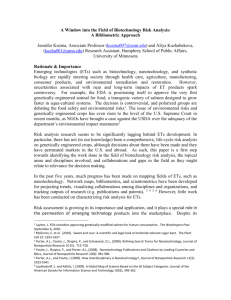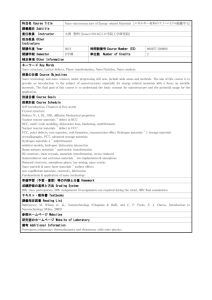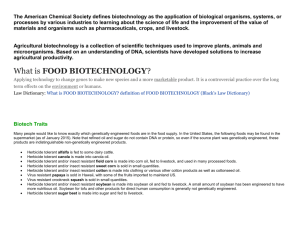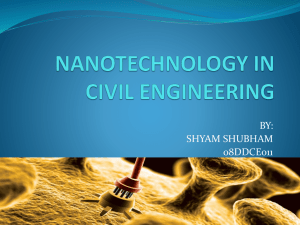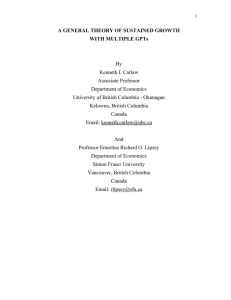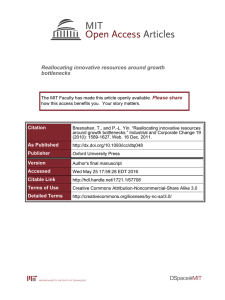Post-debate response to Jackson and Victor on limits to growth
advertisement
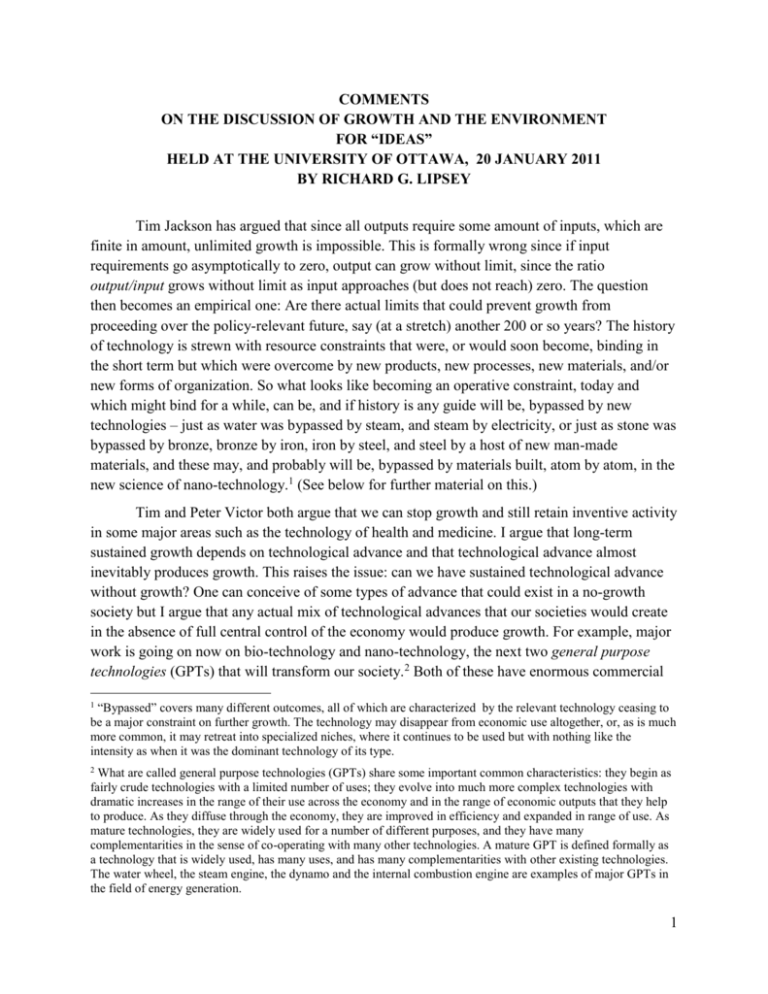
COMMENTS ON THE DISCUSSION OF GROWTH AND THE ENVIRONMENT FOR “IDEAS” HELD AT THE UNIVERSITY OF OTTAWA, 20 JANUARY 2011 BY RICHARD G. LIPSEY Tim Jackson has argued that since all outputs require some amount of inputs, which are finite in amount, unlimited growth is impossible. This is formally wrong since if input requirements go asymptotically to zero, output can grow without limit, since the ratio output/input grows without limit as input approaches (but does not reach) zero. The question then becomes an empirical one: Are there actual limits that could prevent growth from proceeding over the policy-relevant future, say (at a stretch) another 200 or so years? The history of technology is strewn with resource constraints that were, or would soon become, binding in the short term but which were overcome by new products, new processes, new materials, and/or new forms of organization. So what looks like becoming an operative constraint, today and which might bind for a while, can be, and if history is any guide will be, bypassed by new technologies – just as water was bypassed by steam, and steam by electricity, or just as stone was bypassed by bronze, bronze by iron, iron by steel, and steel by a host of new man-made materials, and these may, and probably will be, bypassed by materials built, atom by atom, in the new science of nano-technology.1 (See below for further material on this.) Tim and Peter Victor both argue that we can stop growth and still retain inventive activity in some major areas such as the technology of health and medicine. I argue that long-term sustained growth depends on technological advance and that technological advance almost inevitably produces growth. This raises the issue: can we have sustained technological advance without growth? One can conceive of some types of advance that could exist in a no-growth society but I argue that any actual mix of technological advances that our societies would create in the absence of full central control of the economy would produce growth. For example, major work is going on now on bio-technology and nano-technology, the next two general purpose technologies (GPTs) that will transform our society.2 Both of these have enormous commercial “Bypassed” covers many different outcomes, all of which are characterized by the relevant technology ceasing to be a major constraint on further growth. The technology may disappear from economic use altogether, or, as is much more common, it may retreat into specialized niches, where it continues to be used but with nothing like the intensity as when it was the dominant technology of its type. 1 2 What are called general purpose technologies (GPTs) share some important common characteristics: they begin as fairly crude technologies with a limited number of uses; they evolve into much more complex technologies with dramatic increases in the range of their use across the economy and in the range of economic outputs that they help to produce. As they diffuse through the economy, they are improved in efficiency and expanded in range of use. As mature technologies, they are widely used for a number of different purposes, and they have many complementarities in the sense of co-operating with many other technologies. A mature GPT is defined formally as a technology that is widely used, has many uses, and has many complementarities with other existing technologies. The water wheel, the steam engine, the dynamo and the internal combustion engine are examples of major GPTs in the field of energy generation. 1 possibilities that will produce new products, new process and new materials. If we are going to exploit the medical advances that these two technologies offer, we will inevitably uncover growth creating commercial opportunities which will be developed among side them. Here are just a few things we can expect from these two technologies whose effects are just beginning to be felt, more from bio and less from nano as yet.3 Nano-technology: The technology of producing goods from the bottom up by assembling individual atoms and molecules is just beginning to make its effect felt. Conceptually, however, this technology promises the greatest revolution in production since the first stone tool was produced by flaking chips off flints. Current “bulk technology” takes materials and pares away the unwanted parts to be left with what is wanted. Nano-technology handles individual atoms and molecules, building them precisely into desired aggregates, which may be no more than two or three molecules, or may be an object observable to the naked eye. All goods, manufactured or natural, are composed of atoms. When the atoms are rearranged, the resulting goods are changed. For example, the difference between a diamond and a piece of coal is solely in the arrangement of their atoms. The power to rearrange atoms at will, not long ago thought forever out of our reach, will have staggering implications for the production of economic output. Nanotechnology is already interacting with other GPTs, including biotechnology and the computer, without which it would have been impossible. The technology does not yet have all the characteristics of a GPT. It has yet to enter the economy in an important way, and many of its applications are either still only on the drawing board or in designers’ imaginations. Yet if nanotechnology fulfils even a significant fraction of its potential, it will become one of the most important GPTs of the coming century. If it meets most of its already-perceived potential, it could become the most important GPT in all of history, rivalled only by electricity. Nanotechnology has a number of key characteristics. The first is the ability to produce almost any shape or structure, so long as it obeys the basic laws of physics. The second is the ability to produce goods for a cost only a little more than the cost of the raw materials. The third, and most important, is the ability to get every atom into its precise place. Manipulating matter at the molecular level allows matter to be treated as a computer treats data, transforming it, manipulating it, and reproducing it with perfect precision. This one characteristic of nanotechnology will have huge implications. Just as the increase in the quality of materials allowed fundamental changes in the design of aeroplanes, the increase in precision allowed by nanotechnology (affecting hardness, durability, and creating specifically tailored characteristics) will fundamentally change everything from electronics to construction. The material on nano- and bio-technology is drawn from Richard G. Lipsey “Sources of Continued Long-Run Economic Dynamism in the 21st Century” in The Future of the Global Economy: Towards a Long Boom, (Paris: OECD) 1999, 33-75. 3 2 Nanotechnology has already started to revolutionise medicine where many of the advances in biotechnology rely on nanotechnology. It is being used to produce medical machines the size of a few hundred atoms to practice nano-medicine, which includes non-intrusive surgery. The production of new materials will include new polymers with strength and bonding characteristics that have never been seen before. Nanotechnology will be used to reduce the size and cost of computers, and truly molecular computers may not even use electronic effects. One result will be the production of really massively parallel computers. Other nano-products will simplify housekeeping. Dirt digesting machines will make everything from dishes to carpets selfcleaning, while keeping household air permanently fresh. Nanotechnology will also produce fresh food by mimicking cell growth in plants and animals. Nano-receptors on TV sets will provide hi-definition only dreamed of today. Tools will be harder, more durable, and separately created for each specific purpose. Batteries will be minute and long-lived. Fuel efficiency of automobiles (should they still be around) will be enhanced when the spark plugs are replaced by nano-plugs. Aeroplanes will fly faster, higher, longer, and safer when made with nanoengineered materials. Medical implants will be more effective and more durable, and so on, and so on. “…nanotechnology could have more effect on our material existence than those last two great inventions in that domain—the replacement of sticks and stones by metals and cements and the harnessing of electricity.” (Minsky, in Drexler.) Not quite in the realm of science fiction are rooms filled with air borne nano-machines no larger than a molecule of air but with substantial computing power. The slightest thought command would produce any desired action from those machines, from levitating a bottle of beer out of the refrigerator and into your hand, to repelling an unwanted intruder. Does that sound too fantastic to be even entertained as a possibility? If so, think of how listeners would have reacted in 1910 if you told them that within one hundred years all that has ever been printed, all that has ever been painted, all that has ever been photographed; and vast amounts of the music that has been performed will all be able to be expressed as a series of “zeros” and “ones” and then stored in such compact form that any part of it can be searched for and viewed on a small electronic device located anywhere in the world; its compactness will be such that any one person can store the contents of a vast library or art gallery on a stick-like device no larger that a small pencil! What this thought experiment shows is that we cannot even begin to know all that the future of 100 or even 50 years hence will bring by way of new transforming technologies. Biotechnology: The second major GPT of the future that is already making a major impact on us is biotechnology, which is projected to be one of the most important GPTs in the first half of the 21st century.4 Like all GPTs, it was not initially clear just what applications would emerge 4 Although biological engineering through selective breeding is as old as the Neolithic agricultural revolution, modern biotechnology begins with the 1953 discovery of the structure of DNA as the carrier of the genetic code. The next breakthrough was the discovery of a family of enzymes called, restriction endonucleases, that can recognise a particular sequence in DNA and cut it at the required point, allowing a given set of DNA fragments to be reproduced at will. Another technique allowed the various fragments of DNA to be separated into homogeneous 3 before each technique was perfected and applied—although it was obvious to most observers in a general way that the possibilities were enormous. As is always the case, the discovery of new knowledge is well ahead of its practical applications, although these are beginning to multiply in the explosive way that is typical of really important GPTs. Here are just a few examples. Medical: The original use of monoclonal antibodies was to fight disease. But surprising applications uses have been developed that use their ability to locate and mark any target. This allows them to be used in a range of techniques for diagnosis, treatment, monitoring, autopsies, drug purification, and screening. New biomaterials are now routinely manufactured from animals’ own tissues. The eventual aim is to use the patient’s own genetic material to manufacture anything from skin to organ tissue which can then be returned to substitute for defective material with no fear of rejection by the patient’s immune system. Stem cell research gives promise of being able to regenerate any one of a patient’s entire organ, using his own cells as seeds to prevent rejection, thus allowing the replacement of any failing organ. Literally thousands of disorders are now known to be caused by defective genes—cystic fibrosis to mention but one. Gene therapy offers promise of curing many of these. Only slightly further away is the combination of nano-technology and biotechnology to build up therapeutic molecules from scratch using computer models to discover the best fits for the surface of a protein that is to be treated. Although successes and failures cannot be predicted, it is clear that a massive range of successful medical applications of biotechnology is on its way, with the early arrivals already in common use. No one can foresee how much will be accomplished in the next thirty years but it is likely that medical practice will be transformed in myriad ways. Agricultural: The use of biotechnology in food production is full of uncertainties about harmful side effects and, so far, the results have been less than some of the optimists predicted when genetically engineered plant life was first produced in the 1970s. If nothing else, public resistance to genetically engineered foodstuffs is slowing, but not halting, the developments. Genetically engineered bovine growth hormone mimics the natural product made by cows and stimulates milk production. Genetically engineered resistance to diseases is a superficially attractive way of reducing the use of herbicides although many fear that the resistance may spread to weeds. Genetic engineering of grains is being used “…to modify different stages of crop production, from speeding up early growth of food plants, to increasing yields, to slowing down ripening or wilting. Since much of the form and function of a plant groups. A big step followed with recombinant DNA. Fragments of DNA can be joined by use of a “sealing enzyme”, called ligase. Cancer cells, which have the property of unstoppable growth, can then be used to reproduce the recombinant DNA at will. This technique is used to produce masses of monoclonal (single parent) antibodies by fusing white blood cells, which produce germ-fighting antibodies, with cancer cells, which multiply indefinitely. At this point an emerging new technology became an emerging GPT. 4 depends on its genes, the ultimate hope is to engineer optimal plants for every growing condition and market niche.” (Grace p 110-2) Plants can now be made resistant to fungal diseases by exposing them to a genetically engineered weak version of the disease to activate their immune system—a procedure analogous to inoculation in humans. No doubt other diseases will be treated in this way in the future. Also in the works are more exotic ways of controlling pests, such as genetically engineering plants to secrete substances that harm the bacteria that live within, and are essential to, many plant pests. Mixed strategies are being developed to combat the development of resistance among the target pests. Immunity of enemies to any treatment usually comes from activating a recessive gene. By planting some non-engineered plants amidst engineered ones, the hope is that the nonengineered ones will harbour more pests and, when these interbreed with pests that have developed immunities by feeding on engineered plants, the immunity will be suppressed. This is an illustration of the continued war between engineers and their enemies. As soon as a new technique is developed, defences evolve and the engineers seek ways of meeting these defences. Critics worry that this never-ending arms race will induce too many unpredictable and potentially harmful side effects. In a practice called “genetic farming” genetic engineers are also using plants and animals as factories to manufacture wanted drugs, industrial chemicals, fuels, plastics, medical products, and other materials. Here we see a typical GPT development as the procedure branches out to affect more and more industries that initially were unrelated to biology. Mining: Genetically engineered bacteria, fungi, algae and plants have many potential uses in the mining industry. Examples include recovering metals left in tailings, cleaning up contaminated sites after mines are abandoned, and extracting metal from crushed ores when they are first mined, or even in situ. Techniques that leach the minerals from the ores without removing the ore-bearing rock itself would be one of the most fundamental revolutions in metal extraction since people first began mining and smelting. Forests and oceans: Bio-prospecting is steadily locating new medicines and other useful materials in forests and seas. Animals that live with others that are poisonous often produce antitoxins of great potency—materials that, once understood, can be manufactured in laboratories. Other possibilities just on the horizon include salt-resistant, protein-digesting enzymes that may be useful in cleaning industrial machinery; compounds made by algae and sponges that help plants to germinate and grow; and marine enzymes that combine readily with other chemicals and are then useful in processing medicines, food production and cosmetics (Grace p 170). Marine farming is becoming widespread and bioengineering can be used to speed up maturation, growth, egg production and raise survival rates of offspring. As with any major new technology fish farming has had its major setbacks stemming from the inability to predict some of the harmful effects of raising marine animals in unusual environments. But many of these are being slowly overcome as operators move down their learning curves. 5 Many new techniques are begin developed for the forest industry, one of the most promising being micro-propagation, which clones trees. Its advantages include cheap, fast, mechanised production of trees for reforestation; and the ability to genetically engineer and clone stocks of transgenic trees. Currently, industrial plantation of forests is criticised for major environmental impacts. Genetic engineering of farmed trees looks for new species to improve soil fertility and reduce the need for fertilisers and herbicides. Clearly, biotechnology is evolving just as we would expect a major GPT to do. It is a GPT developed enough to be sure that it has many potential uses but not fully developed enough even to guess at some of the revolutionary new uses still below the horizon. One of the unfortunate uncertainties around bio-technologies is the large degree of social risk. Risks of unfortunate, even disastrous, side effects are a major concern, especially since uncertainty is everywhere—there is no way we can rule out the possibility of producing a product that does massive harm before we learn how to control it. _________________ This discussion of two of what will be the 21st century’s several new transforming GPTs should offer a note of caution to the pessimism of the no-growthers’ alleged impossibility of sustained growth over the next few centuries. Physics can often tell us the theoretical possibilities latent in some new technology but it cannot predict what applications can be developed over any given time period and at what economic cost. But it is certainly within the realm of physical possibility that we will solve the problems associated both with hydrogen fuel cells and atomic fusion. The latter would then be used as a method of producing heat to generate electricity as we now can use atomic fission, generating unlimited energy from virtually inexhaustible atomic sources with virtually no harmful side effects (the main by-product being H20). This electricity could then be used to power all major static power users and to make the hydrogen needed for fuel cells to power mobile and small static users. Nano-technology might then produce new materials from the world’s practically unlimited source of atoms to be used in new materials. Of course, we do not know when, or even if, these things will come to pass, but the fact that they are well within the realm of possibility suggests that technological advance cannot be dismissed as a means of removing currently threatening growth constraints. If this seems unlikely, it is worth remembering that starting in 1800, there is no way that the GDP of any one subsequent year could have been produced by the technologies ruling 50 years previously. Just as the GDP of 50 years from now, assuming growth as its present rates, could not possibly be produced by present-day technologies. Nothing said so far argues against the existence of the pending environmental crisis, most importantly that of global warming and its associated climate changes. But it does suggest that there are no strong reasons for dismissing the possibility that technological change will provide the main method of dealing with the crisis over the long haul without attempting the politically 6 difficult (I would say impossible) job of adopting measures designed to drastically reduce or even eliminate economic growth. Before that time, the urgent task is to adopt technologies and public policies that already exist, or are on the drawing boards, to make a major advance in dealing with the harmful environmental effects of production technologies in current use. So the issue is to do everything possible to do this through such measures as correctly pricing (or taxing) carbon emissions while encouraging the developments of new technologies that will have vastly improved envormental impacts. What we mainly lack is the political will to seriously tackle the first part of this job now. VANCOUVER , B.C., 25 January 2011 7
